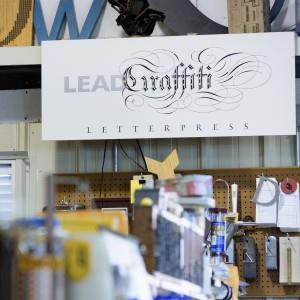
Teaching African American Material Culture with Digital Humanities
The Teaching African American Material Culture with Digital Humanities project is a two-course series taught through a partnership with the English Department and the Special Collections and Museums. The project is designed to promote engagement with primary source research and the use of digital methods and technologies in the classroom. The projects course offerings include a fall 2017 semester undergraduate course and a spring 2018 semester graduate-level seminar. Both courses center on the handling, description, and analysis of ephemera as texts, and each combines on-site collection research opportunities with skill development in digital scholarship. Digital Archive Production, an undergraduate research and writing course, is the first course in this series. Using contemporary database design methods and object-based learning as the pedagogical foundation for instruction, students were paired in groups and tasked with processing various pieces of ephemera from the Gregory C. Wilson Collection of African American Trade Cards and Postcards. This collection consists of racist ephemera from the Jim Crow Era contrasted by a smaller assemblage of cards that celebrate African American cultural heritage. During the course of the semester, students were acquainted with concepts of race and racial theories alongside their work in ephemera studies. Through readings, lectures, and research, they cultivated a comprehensive understanding of the history of racial stereotypes as exhibited in the performative tradition of American blackface minstrelsy and its offshoots. The students were then encouraged to connect this new understanding of racial caricature to larger trends in American literature, theatrical performance, and film. Furthermore, they were required to apply critical thinking skills to their analyses of the different ways in which racial caricature survives in new media and social media. In learning about material culture, students had the opportunity to acquire analytical tools for interpreting graphic design trends in accordance with theories of structural and post-structural semiotics. The course had an emphasis on connecting knowledge of print and graphic design history to theories on race and race relations. Specialized tours and course activities included a screening of various relevant early-to-mid-twentieth century film and television series, a street and business signage tour of Newarks Main St., and a printing workshop at Lead Graffiti Letterpress Studio lead by Ray Nichols and Jill Cypher. For their final projects, each of the student groups provided material metadata and contextual essays for at least three cards in the collection. This content was ultimately added to a collaborative course database that was produced with Google Sites. The second course in this project, Scrapbooks as Literary Documents, is taking a critical look at the scrapbooks of poet, teacher, and activist, Alice Dunbar-Nelson (1875-1935). The focus of this seminar involves the reassessment of the value of the scrapbooking tradition, particularly with respect to its history in the African American community. Here we explore the multifaceted nature of Dunbar-Nelsons identity through the multimodalities of the scrapbook format. Students are pulling from their close readings of Dunbar-Nelsons fiction and journalism, as they combine archival research and documentary materials from our course activities to achieve the specific course outcomes. Activities developed in coordination with the Winterthur Library and the Delaware Historical Society have allowed students to work directly with a wide array of nineteenth and twentieth century scrapbooks during scheduled site visits and tours. Our work with this format, however, does not stop at the level of investigation. In an attempt to think past conventional models for literary research, this course integrates scrapbooking practice in its writing assignments. In keeping with established methods in compositional development, the students in this course are responsible for producing an academic book review, a descriptive essay on a scrapbook of their choice, and a framework essay that advances scholarship on the life and works of Alice Dunbar-Nelson as an important historical figure. Yet the distinguishing factor here is that the students are producing Adobe Spark-based digital scrapbooks for their final projects. Each of the digital scrapbooks will tell a visually oriented account of the individual arguments first put forward in the framework essays. The materials produced and acquired for these digitally meditated scrapbook pages are embedded with additional layers of digital content. Using augmented reality technology (AR), then, we will reformat all of this content in printed AR clippings that we will use in paper-based scrapbook pages. Later, we will compile these individual scrapbook pages in a collaborative course scrapbook that will be exhibited in the University of Delaware Library at the end of the semester. Guest lecturers, facilitators, and reviewers, including librarians, historians, and scrapbook theorists and specialists, are participating in the course by supporting both the supplementary activities and the final projects.
